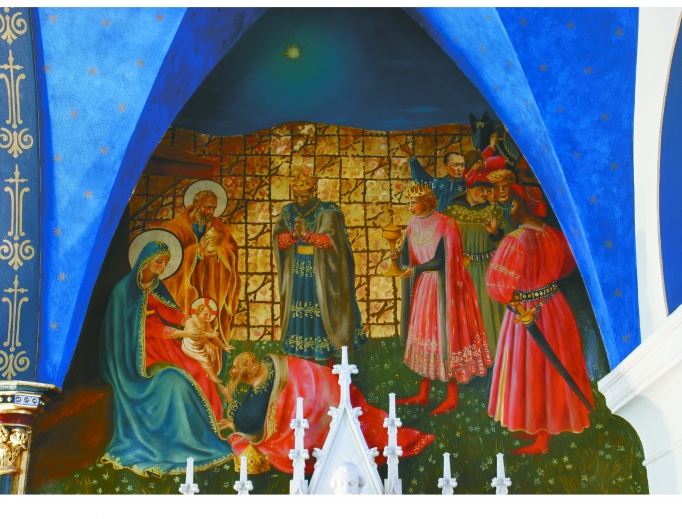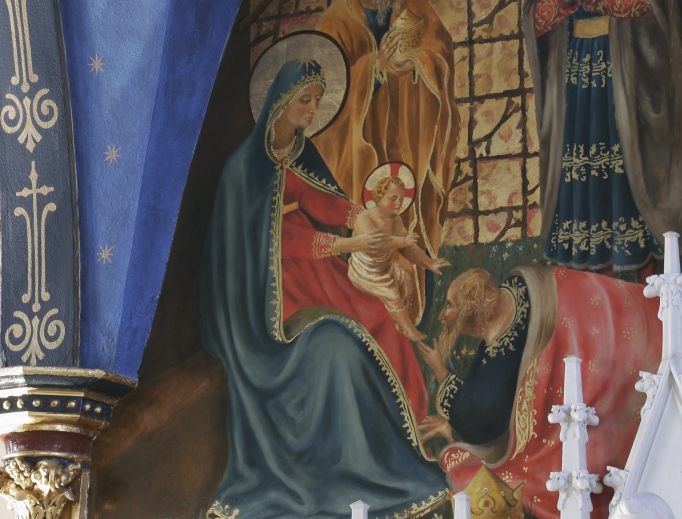Painting Christ’s Story: Celebrating the Sacred Vision of Fra Angelico
Shrine in Peoria, Illinois, offers beauty via reproductions of the work of the renowned artist.

Peoria, Illinois, may be known as the home of Fulton J. Sheen’s tomb (and the Archbishop Fulton Sheen Museum) — but it’s also the host city for the Shrine to Blessed Fra Angelico (1395-1455) — the only official shrine in the United States dedicated to the Church’s patron of artists. Reproductions of Blessed Fra Angelico’s celestial artwork grace the apse, the side shrines and elsewhere.
For a glimpse at Fra Angelico’s importance, after viewing one of his works, the famed Michelangelo once said: “One has to believe that this good monk has visited paradise and been allowed to choose his models there.”
In Lives of the Artists, Georgio Vasari described Fra Angelico’s painting of the Annunciation as “so devout, delicate, and well-executed that it truly seems to have been created in Paradise rather than by a human hand.”
Saintly Style
While not the originals, of course, the shrine’s replications and original works based on the late-medieval artist’s style help visitors realize Fra Angelico’s great gifts. Right away the sanctuary draws one’s attention to the early 20th-century marble high altar, with its ornate gothic spires and decoration, and to the brilliant biblical scenes filling the apse, all with the trademark colors of Fra Angelico: ultramarine-like blues, pinks, reds and sparkling golds.
To the left of the high altar is The Deposition, a meditation on Christ being taken down from the cross. Viewers envision the Blessed Mother’s sorrow as she kneels in prayer, while St. John is depicted reaching up to help take Jesus’ body down. The original was painted in the early 1440s. Directly opposite it on the sanctuary wall is The Entombment. Both flank the large crucifix on the central wall directly above the high altar.
Just as Fra Angelico sometimes included contemporaries among the people in his paintings, such as a sculptor-friend in The Deposition, these artists did the same in some of the shrine’s reproductions. In The Entombment, for instance, visitors can find a deceased deacon who, as locals know, was a longtime parishioner.
Directly above these paintings are two famous works highlighting sorrow transformed into joy and glory. One is The Transfiguration — the original dates to 1440-1441 and was done for a cell in the monastery of San Marco in Florence. The second is The Resurrection, better known as Noli me tangere (“Do Not Touch Me”), in which the glorified Resurrected Jesus meets with Mary Magdalen. The original was painted for another monastery cell at San Marco.
High in the gothic arch spanning the sanctuary above the altar, there appears Christ in Glory depicting the Lord as the Divine Judge.
The sanctuary walls radiate with this beautiful art, lifting visitors’ senses to heavenly realms. Below the reproductions and around the altar are depictions of four modern saints commissioned by the shrine — Sts. Teresa of Calcutta, Faustina, Josemaría Escrivá and Padre Pio — visualized in the style of Fra Angelico.
Also in the same style of the beloved Dominican friar-artist, the image on the wall behind the main altar presents a shrine-commissioned depiction of the Crucifixion. When the church was renovated, the original corpus was repainted in Fra Angelico “colors” and the background had elements added, like trees that would appear in his works.
Artistic Inspiration
During early renovation stages in 2002, St. Mark’s pastor, Father Benjamin Reese, happened to be in Rome. He was celebrating Mass in Santa Maria sopra Minerva in Rome on the altar over the tomb of Blessed Fra Angelico. One intention at that Mass was for the church renovations taking place back in Peoria. There was a question at the time about how the renovations should proceed in the way of new artwork, and, reflecting on his celebration of the Mass at Santa Maria, the pastor found inspiration in the patron of artists for the artistic solution for St. Mark’s. All agreed Fra Angelico’s particular style, colors and themes would perfectly fit the renovation and restoration. A parishioner found the artists right in Peoria, at Murals by Jericho, to carry out the work. Peoria Bishop Daniel Jenky rededicated the restored church on the Solemnity of Christ the King and designated it as a shrine to Blessed Fra Angelico on the feast of St. Joseph, March 19, 2004.
Msgr. Brian Brownsey, the current pastor, said he gets “loads of comments … about the environment in general at St. Mark’s. The artwork certainly contributes to that. There’s a peacefulness contributed by the artwork. Our worship space draws your mind and heart up to the heavenly realities.”
Those realities continue under the beautiful blue ceiling filled with gold stars, as parishioners and visitors alike are drawn to the Marian and St. Joseph altars on either side of the sanctuary.
At the St. Joseph side altar, the Fra Angelico reproductions present The Law of Love, with scenes from the life of Christ — the Nativity, Circumcision, Presentation in the Temple, Flight Into Egypt, Massacre of the Holy Innocents, and Finding of the Child Jesus in the Temple — since Joseph was part of these moments as well as the moment depicted in the major mural above the altar, Adoration of the Magi. Parishioners recognzie that former pastor Father James Fitzgerald and two other priests familiar to them — one a former St. Mark’s associate pastor and the other a former chaplain from St. Joseph Newman Center at Bradley University — appear in this mural.

Above the Marian altar, as the backdrop behind the statue of Our Lady and the Child Jesus, is the magnificent Coronation of the Virgin. Fra Angelico completed the original around 1432-34.

“I always like the Gospel of Luke, the Marian Gospel, to me,” Msgr. Brownsey explained. “She’s definitely present. And that definitely comes out in the artwork of Fra Angelico. There are so many of the images with Our Lady — this constant theme. Wherever you’re looking, there’s Our Lady.”
Patron Artist
The Marian emphasis in Fra Angelico’s work, such as a focus on the mysteries of the Rosary, surely is related to his own spirituality as a Dominican priest and the Dominicans’ Rosary mission. Born Guido di Pietro, Fra Angelico became a Dominican in 1418 and took the name “Giovanni.” Based in Fiesole and already an exceptionally talented artist, Fra Angelico was given the job of decorating the cells and passages of the monasteries with religious works to aid the religious’ meditation. Then came his next role: decorating chapels and churches. Pope Nicholas had him come to the Vatican to paint such works as portraits of the Four Evangelists; these are also reproduced in St. Mark’s.
Even during his lifetime he was called “Angelico” because, as Vasari wrote of one work, everything from color to form to expression “seems to have come from the hand of such a saint or angel as these (in the painting).” It is known that Fra Angelico led a holy life and never picked up a brush without offering a prayer first. He himself said, “He who wishes to paint Christ’s story must live with Christ.”
Fra Angelico is pictured in one of the medallions on either side of the Marian altar. Joining him are other saints intimately associated with Mary — Juan Diego, Bernadette of Lourdes and the two Fatima children, Jacinta and Francisco. The third of these children, Servant of God Lucia dos Santos, is depicted there, too.
The Fatima children are a big draw at this shrine. “People tend to be around them quite a bit,” Msgr. Brownsey said. All the reproduced works certainly help parishioners, locals and visitors from Bradley University, where Msgr. Brownsey is chaplain, grow in their faith-filled worship. The students love the “awe, beauty and mystery” of the candlelight Mass, “the environment, the artwork.” When parents visit, students tell them, “You have to see the church I go to.”
Image and Word
The pastor shared the church’s connection to another saint in the making — one who used words to present the faith to the world with all the artistic expertise that Fra Angelico had used in bringing holy images to life from color and form: After Fulton Sheen was ordained in 1919, he returned to Washington to complete his studies.
He came home for Christmas that year.
By then, his parents were parishioners at St. Mark’s and living in an apartment directly across the street.
On Christmas 1919, young Father Sheen celebrated his first Christmas Mass at the high altar in St. Mark’s.
Msgr. Brownsey said the church’s high altar is original to the church, and since other churches in the city had high altars removed or replaced, this one is the “only altar in Peoria that’s documented that he said Mass at that altar.”
Every year, “St. Mark’s was his home for Christmas.”
As always, the church will celebrate the feast of Fra Angelico, which falls on Feb. 18 — a celebration of how the holy artist continues to lift minds and hearts to heavenly realms.
is a Register
staff writer.
- Keywords:
- catholic art
- fra angelico
- joseph pronechen

















